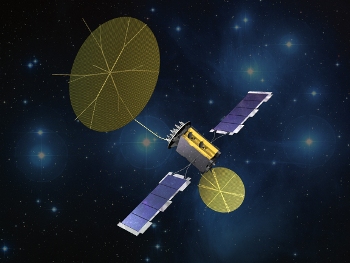Military satellite radios have rarely offered secure data communications while on the move. That’s because older communication systems needed terminals that were stationary and in the open—not ideal for missions when mobility is key and time is of the essence. The Mobile User Objective System, a Lockheed Martin satellite communications network for the U.S. Navy, is changing that.
 Mobile User Objective System
Mobile User Objective System
The concept turned into reality as the system accomplished its first secure data and voice call using a MUOS on-orbit satellite and associated ground stations.
Recently, two General Dynamics AN/PRC-155 Manpack radios successfully completed a secure radio-to-radio voice and data “call” through the MUOS satellite network, as part of a scheduled MUOS end-to-end system demonstration. The PRC-155 radio is part of the Handheld, Manpack, Small Form Fit family of radios.
“This first data call demonstrates the MUOS system capability for users who have up to now lacked secure data on the move,” said Iris Bombelyn, vice president of Narrowband Communications at Lockheed Martin. “The Manpack radio is the first of many terminal types that we know are waiting to connect to the MUOS network. Over 20,000 existing terminals are preparing to follow, making MUOS a ready and affordable solution to getting secure voice, data and video to mobile users.”
During the demonstration, one radio successfully transmitted voice and data communications through the orbiting MUOS satellite, to the MUOS ground station, back through the satellite and to a second radio.
MUOS satellites are equipped with two payloads: the Wideband Code Division Multiple Access (WCDMA) payload that provides a 16-fold increase in transmission throughput over the current Ultra High Frequency satellite system, and a legacy payload that works seamlessly with currently-fielded terminals. Earlier this year Lockheed Martin delivered the completed waveform, developed by General Dynamics, to the U.S. Navy. The waveform, now published in the government’s library, allows radio developers to integrate the software into existing radios so they can realize the benefits of the MUOS network.
The second MUOS satellite will ship next month to Cape Canaveral Air Force Station, Fla. for launch in July. After certification of the ground and terminals for use, the WCDMA payloads on both MUOS satellites will be usable by warfighters in the field.